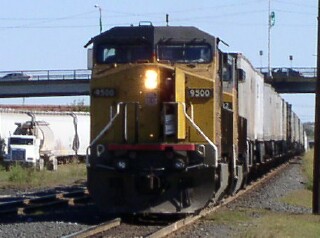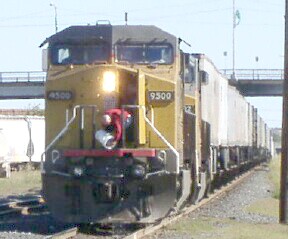
At 10:45, this arrived and stopped on the main track:

You might notice a second track in the picture. It was being used to store empty boxcars. At 11:20, the crew managed to get changed and the freight departed. We thought Amtrak was parked behind this freight, waiting to arrive at Del Rio. Nope...
At 11:35, we were bored and left. I later found out that Amtrak arrived at 12:12.
Is it true that UP only hires Indonesians for their dispatchers?
Hey, I'm sure there are some good looking dispatchers - I certainly saw one or two at BNSF's NOC!
Geoff M.
quote:
I'm trying to work out whether the Indonesian comment was a compliment or a racist slur? Can you clarify...?
"Racist slur"? Huh???
No offense was intended, just using opposite ends of the spectrum for effect.
Geoff M.
quote:
Originally posted by Gilbert B Norman:
They also hire good looking women as Train Dispatchers, if a photo appearing on the back cover of their 2003 Annual Report is to be believed.
I regularly hear one woman on the scanner as one of several people identified as "Dispatcher 5-8". She has an attractive voice. All of the dispatchers I hear sound like they grew up in the midwest.
See also http://www.uprr.com/aboutup/diversity/index.shtml
[This message has been edited by Mr. Toy (edited 12-01-2004).]
Whats inside a dispatch office...seems kinds cool...do they have any computers/rail cams to see the tracks?
My statement was a slam against UP dispatchers, and their lack of RR experience, nothing else.
It was interesting noting the people that apparently saw "racism" where there was none. Are we too PC?
PC? Women should be treated as equals, and as such, should cut the grass, mend their cars, and the "ladies first" rule no longer applies!
Geoff M.
Since this board is essentially unmoderated, may I suggest we "move on'?
But, I must say, Mr Smith, considering you likely took such under "grab bag' conditions, nice photo of C-44 #9500 with its "distinctive' nose.
[This message has been edited by Gilbert B Norman (edited 12-02-2004).]
Aloha nui loa,
Frank in cool but sunny SBA

Also, the Keystone Kops had method to their madness, therefore they would not be a good analogy for UP dispatchers...

And for the other's... Yea... I don't know squat about railroads outside of the USA.... 
Nor do I give a flip about anyone's skin color or Country of origin. I prefer to judge people on their character.
[This message has been edited by mikesmith (edited 12-02-2004).]
By the way, I did not consider your statement as racist. In fact I consider the charge of racism as another label frequently used to avoid thinking. I simply considered it ignorant.
When it doubt, it is far better to keep your mouth shut and let people wonder if you might be ignorant than to open it and prove your ignorance. A closed mouth gathers no feet.
While I have not been to Indonesia, some other members of my family have, and I have worked with a number of people from there in another project.
To educate you a little on the subject, as Geoff M. said, they have about 6500 km of railroad. That is 4,000 miles. It is mostly on the island of Java, which is very densely populated, so they do have a very intense and heavily used passenger service.
The following represents about 15 minutes with the CIA Fact Book on line, plus a few things I already knew: Indonesia has a population of 238,500,000 which makes it the 4th most populous country in the world. It consists of 17,500 islands, of which 6,000 are inhabited. Land area is 1,825,400 sq km (equals 705,200 square miles) or about 3 times the size of Texas. Java is the most populous and most densely inhabited, and the location of most of the railroad milage. The entire country is in a very active area geologically, having frequent earthquakes and numerous volcanos. It has a democtratic form of government, following many year of rule by Suharto, has a literacy rate of nearly 90%, a life expectancy of near 70 years, so it is no primitive backwater. They do have problems with Muslim terrorist and insurgent groups in spme parts of the coutry. Since the country straddles the equator, it looks deceptively small on the normal Mercator projection world map.
So, Mr. Smith, know before you speak.
George
I have no first hand and very little second hand knowledge of how well or poorly the Indonesian railroad operate relative to the UP. I do know this, most systems outside the US treat trains staying stopped for more than a few minutes, whether freight or passenger, as unacceptable. Their track layouts and dispatching staffs are developed accordingly. This usually takes more people that most US systems seem willing to hire to direct train movements. Notice, I did not say more track. The existing Taiwan Railroad system, whose main line totals about the north east corridor plus slightly less then the RF&P if you consider the NEC as circling so that Boston and Richmond are the same place, manages to move more trains and haul more people on a lot less track. There are no 3 track and 4 tack sections, and the portion that is more or less equivalent to New Haven to Boston is single. If you are on a local, you may pull into a local station and sit for 2 to 3 minutes, watch a fast train whip by, wait 2 more minutes and then pull out. Occasionally you have to wait for two trains. Of course, we are somewhat slower. The system speed limit is 130 km/h, which is just over 80 mph.
Anyway, with such a large portion of UP's workforce reaching retirement age-I can imagine that the capacity/dead-crew issue will only get worse. UP is one of the fastest hiring companies in the nation, but I gues they're finding it hard to find qualified applicants. Also, why would UP be just letting a bunch of boxcars sit on a siding like that? Doesn't that cause capacity problems for them as well as Amtrak? I've seen them do the same thing in Glendale, Ca. and along the Zephyr line in the Rockies. Do they honestly have nowhere else to dump them off?
------------------
Patrick
Could be that they really don't have anywhere else to stick them. Most railroad companies have persued a policy of removing "unnecessary" track in yard and elsewhere, secondary mains, and parallel lines so that they have no place to put out of service cars.
SP went through this also in the 70's. Their people learned how to operate a railroad held together with chewing gum and string, but I have heard that UP got rid of most the older SP types.
It is interesting to watch the parallel. BNSF is adding second track like mad between Kansas City and Albuquerque, but meanwhile, there is no noise about "meltdown" over there either. It would be interesting to compare the train density and train delays on the Empire Route with the Sunset Route, both of which are mostly single track.
George
I can only speak of one experience in the BNSF NOC watching the Hi-line (which I specifically requested to see). It was busy with meets every 3-5 sidings it seemed, a mixture of slow freights, fast freights, and Amtrak.
But they had a kind of meet planner on that workstation which suggested meets based on the previous month's history for each train (sectional running times) and the siding vs train length. A dynamic train graph showed the planned timings.
But it was not infallible. The dispatcher showed the effects of placing a block on the mainline for 4 hours. The meet planner planned on putting half a dozen long freights into one short siding!
Geoff M.
What BNSF, and presumably most majorRR's,does
is use the "planning tools" for the usual situations and be prepared to improvise as necessary when the unusual occurs.
In the situation mentioned, what a piece of "intelligent" software would have done is put all the approaching trains into the next available siding. Sidings were sufficiently numerous and trains relatively less so, to enable one train to be placed into each siding. Instead its plan was to get all the trains as close to the blockage as possible, thus resulting in the scenario mentioned.
These tools may indeed be planning tools but how can a planning tool come up with such a daft plan?
I did take some pictures but having no flash and no tripod meant they came out rather blurred.
Geoff M.
How long ago was this visit to the NOC?
Were you actually along side the dispatcher in charge? If so, what an inviable duty!!
From what I now understand, the dispatcher and his supervisor "take hold" of this type of situation. It would seem that the efficient operation of THE TRANSCON as recently describded by Fred Fraily in TRAINS
would be evidence that a very good system is
operating in today's NOC at Ft. Worth.
So the day came, this was about 18 months ago now, he took me on a tour of the building, and then down onto the operating floor. There we spent nearly 2 hours looking at various dispatcher's workstations. Some dispatchers were quite happy to talk about their area, problems, etc, although a couple were just too busy. I can't remember all the workstations we visited but there was one local one (north of Fort Worth), one doing the Chicago suburbs (Naperville area?), and the Hi-line. Quite amazing watching them dispatching the trains 1500 miles away! But that distance also affects the control equipment. Commands to remote interlockings took up to 30 seconds for confirmation to come back, for example.
All in all, a very interesting day, thanks to BNSF!
Geoff M.